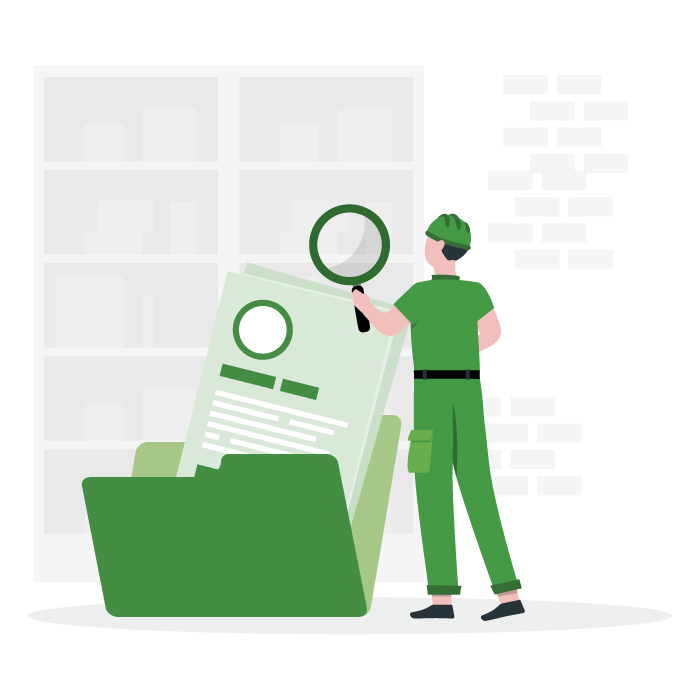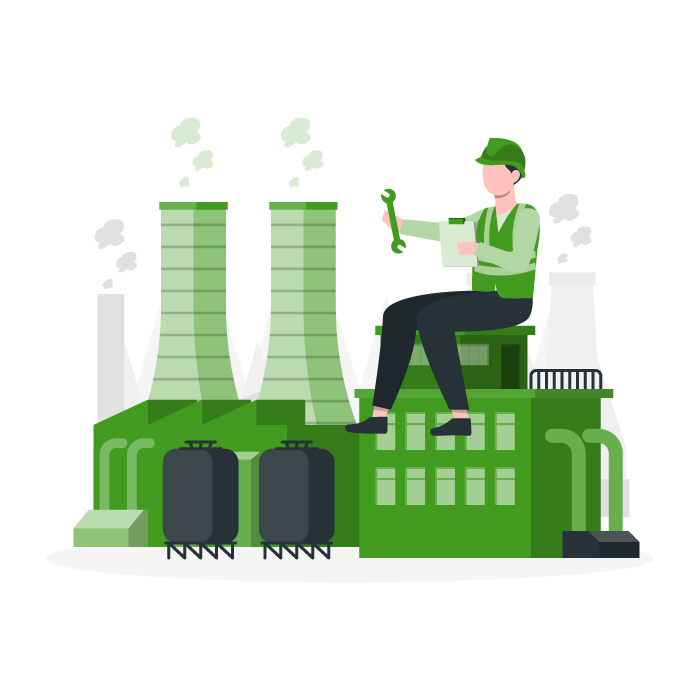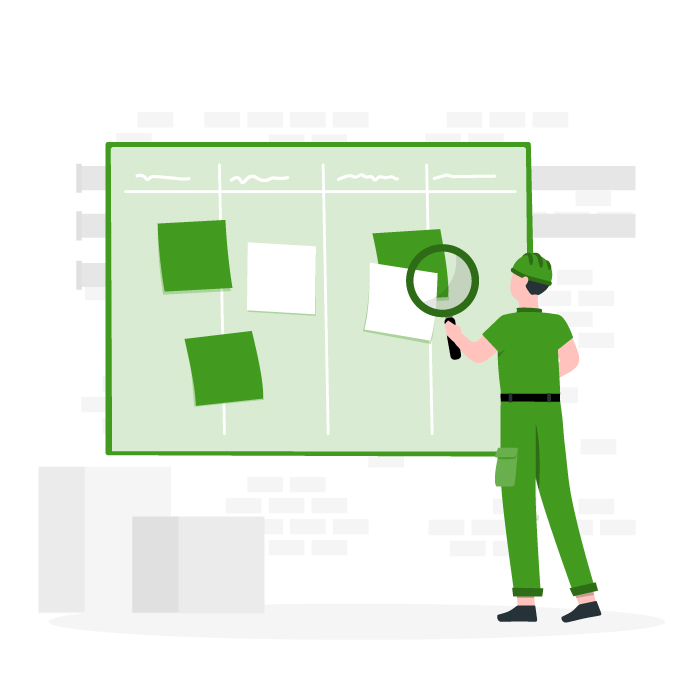Preventive Maintenance
Preventive maintenance (PM) involves routine, scheduled maintenance to prevent equipment failure, reduce downtime, and extend asset lifespan.
Preventive maintenance has numerous proven benefits including reduced repair costs, improved inventory control, and optimized allocation of resources. Despite these clear benefits, more than 60% of businesses still rely on strictly reactive maintenance strategies—addressing equipment malfunctions and failures only after they have already occurred.
A strictly reactive approach can lead to prolonged downtime, elevated maintenance costs, penalties for non-compliance, and safety risks to your employees and customers. Preventive maintenance offers a powerful antidote–a proactive framework for avoiding these outcomes. But what is preventive maintenance (PM) exactly, and how can your organization build or improve your preventive maintenance program?
Below, we offer a comprehensive guide to help you refine your preventive maintenance strategy, and ultimately improve performance and productivity across the entire organization.
Table of Contents
- Preventive maintenance (PM) involves routine, scheduled maintenance to prevent equipment failure, reduce downtime, and extend asset lifespan.
- What is preventive maintenance (PM)?
- Why is preventive maintenance important?
- Different types of preventive maintenance
- Preventive maintenance programs: getting started
- How does preventive maintenance software benefit organizations?
- Preventive maintenance in action
- The future of preventive maintenance
- More resources for getting started with preventive maintenance
- FAQ
- Related Content
What is preventive maintenance (PM)?
Preventive maintenance (PM) is a proactive approach to asset management that involves regularly scheduled inspections, equipment servicing, and preemptive repairs of physical assets including equipment, vehicles, facilities, and infrastructure. Preventive maintenance programs may rely on activities that are scheduled according to time-based maintenance intervals or usage-based maintenance triggers, as well as on performance indicators that suggest the need for maintenance intervention.
Examples of preventive maintenance include equipment testing, cleaning, calibration, lubrication, replacement of aging components, and more. This strategy differs from reactive maintenance, in which maintenance tasks are triggered only when equipment malfunctions or fails.
The primary goals of preventive maintenance are to:
- Ensure availability and reliability of critical assets
- Maximize efficiency of equipment
- Extend the lifespan of physical assets
- Reduce downtime
- Address issues before they escalate into larger, more expensive issues
The core fundamentals of an effective preventive maintenance program are:
- Detailed asset inventory including serial numbers, location, specifications, maintenance history, and real-time tracking
- Preventive maintenance (PM) scheduling based on a combination of manufacturer recommendations, equipment usage patterns, and maintenance history
- Condition monitoring through a combination of inspections, sensors, diagnostic tools, and predictive maintenance data
- Standard operating procedures (SOPs) for each maintenance task ensuring consistency, compliance, safety, and accountability.
- Coordinated inventory management ensuring that spare parts and materials are available as needed, but not overstocked
- Data-driven decision-making for more optimal PM schedules, more accurate usage monitoring, and more precise forecasting
- Continuous improvement through regular performance reviews and consequent identification and reconciliation of gaps in your preventive maintenance program
Free CMMS Buyer's Guide
Discover everything you need to know about CMMS in this comprehensive guide. Begin your maintenance journey now!
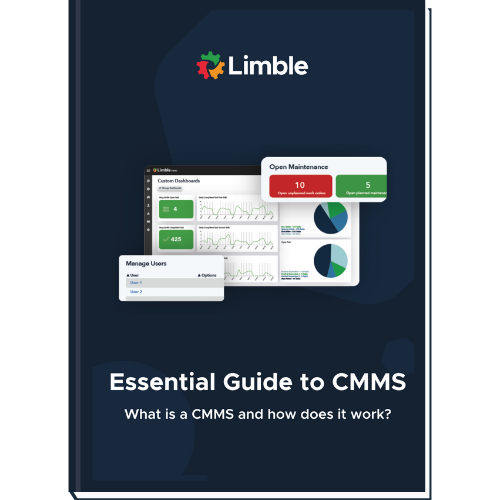
Reactive maintenance vs. preventive maintenance
Preventive maintenance presents a stark contrast to reactive maintenance in both approach and outcomes. As noted in the section above, reactive maintenance–sometimes also referred to as “run-to-failure” or “breakdown maintenance“–is an approach in which maintenance and repairs are initiated only after equipment malfunctions.
Naturally, malfunctions, breakdowns, and emergencies can occur in any operational context. It is vital that your maintenance team has procedures in place for handling reactive maintenance demands. However, an over-reliance on reactive maintenance can increase the likelihood of:
- Frequent and unexpected equipment failure
- Prolonged unplanned downtime
- Operational disruption, missed deadlines, and failed deliveries
- Costlier repairs and replacements
- Shortened equipment life expectancy
- Increased safety hazards and risks of regulatory noncompliance
By contrast,the advantages of preventive maintenance strategies such as regular inspections, routine servicing, and preemptive repairs of critical equipment may include reduced downtime, prolonged equipment lifespan, and lower maintenance costs.
Indeed, a report from Viking Analytics finds that companies that use preventive maintenance strategies in lieu of over-reactive maintenance strategies save between 12% and 18% on repairs. Moreover, the report finds, every dollar spent on preventive maintenance saves an average of $5 on future maintenance and operational expenses.
And yet, according to the report, some 52% of manufacturing companies still lean heavily on run-to-failure maintenance strategies.
Major elements of preventive maintenance
Managing an effective preventive maintenance (PM) program requires a structured framework that includes the following elements:
- Complete inventory of all assets, including equipment, machinery, facilities, and systems as well as documented maintenance history for each asset
- Preventive maintenance calendar outlining when each piece of equipment requires maintenance based on time (e.g., monthly, quarterly, seasonal, annual, etc.) or usage (e.g., hours of operation, miles driven, production cycles, etc.)
- Automated scheduling tools, work order alerts, and inventory restocking triggers
- Standard operating procedures (SOPs) detailing inspection criteria, service steps, safety protocols, and guidelines for addition PM tasks
- Task prioritization based on asset criticality and the potential operational impact of failure
- Condition-based monitoring using sensors and diagnostic tools to track real-time asset performance, identify early signs of wear, and intervene to prevent malfunction
- Predictive analytics based on a combination of real-time and historical data
- Qualified technicians who are fully trained in performing maintenance tasks, interpreting diagnostic data, and remaining up to date on current best practices
Why is preventive maintenance important?
The benefits of adopting a successful preventive maintenance approach include:
- Reduced equipment downtime and increased operational efficiency
- Extended asset lifespan and maximum ROI on heavy equipment
- Lower repair, servicing, and replacement costs
- Improved safety, compliance, and audit performance
- Optimal equipment performance, reliability, availability, and energy efficiency
- Data-driven decision-making and advanced analytical insights
- Improved project completion times, reduced delivery delays, and heightened customer satisfaction
Preventive maintenance challenges
While the benefits of preventive maintenance are well-established, there are still some practical challenges that come with both the transition to a PM strategy and continued implementation of an optimally effective preventive maintenance program.
Some of the complications of taking a more strategic, forward-looking approach to maintenance may include:
- Over-maintenance of equipment that isn’t heavily used or prone to failure, and consequent unnecessary downtime, wasted resources, and increased costs
- High upfront costs for new technology, skilled labor, and training
- Adjustment to process transformation in key areas including inventory management, work order delegation, task documentation, and more
- Resistance to change, where teams that are accustomed to reactive maintenance may view preventive tasks as unnecessary, tedious, or burdensome
- Lack of historical data on asset performance, making it difficult, initially, to determine the correct intervals for PM tasks
Successfully making the transition from reactive to preventive maintenance
When implemented correctly, the benefits of preventive maintenance work far outweigh the challenges. Follow some of the tips and best practices listed below to simplify your transition and ensure the success of your preventive maintenance program:
- Establish measurable goals for your preventive maintenance program such as reducing unplanned downtime, lowering repair costs, or extending asset lifespans.
- Build a cross-functional team to oversee the maintenance program, involving departments such as operations, production and procurement to ensure alignment on maintenance priorities.
- Prioritize change management by communicating the benefits of preventive maintenance such as long-term cost savings, better equipment reliability, and safety improvements, while providing comprehensive training on changing procedures and protocols.
- Begin with a pilot program focused on your most critical assets and gradually expand the preventive maintenance program to other assets as your team becomes more comfortable with the process.
- Implement a Computerized Maintenance Management System (CMMS) to ease the transition with advanced features like automated maintenance scheduling, work order tracking, inventory and spare parts management, and centralized data access and controls.
Different types of preventive maintenance
Preventive maintenance can take several different forms. The right maintenance strategy will depend on a number of factors including the nature, usage, and complexity of a given asset. While simpler and less costly assets may be maintained with fairly straightforward servicing schedules, some of your organization’s heavier equipment may require the use of advanced, data-driven preventive maintenance strategies.
Below, we spotlight a few of these advanced preventive maintenance methods:
- Time-Based Preventive Maintenance (TBPM) tasks are scheduled at regular intervals (e.g., monthly, seasonally, annually, etc.), usually based on a combination of manufacturer recommendations and historical data, and will be performed, regardless of the asset’s condition or usage.
- Usage-Based Preventive Maintenance tasks are triggered based on predefined usage metrics, such as miles driven, hours of operation, or number of production cycles.
- Condition-Based Maintenance (CBM) uses sensors and diagnostic tools to monitor specific parameters (e.g., temperature, vibration, pressure) and initiate maintenance activities based on real-time indicators.
- Predictive Maintenance (PdM) uses predictive analytics and machine learning algorithms to forecast and prevent equipment failures based on a combination of historical and real-time data.
The best way to transition toward a preventive maintenance strategy that deploys these advanced practices is to implement a Computerized Maintenance Management System (CMMS), which can streamline the processes of tracking asset data, scheduling maintenance activities, allocating resources, and more.
Preventive maintenance programs: getting started
Building an effective preventive maintenance (PM) program is a long-term investment in the health of your organization’s assets. Below is a step-by-step guide for successfully establishing and managing a preventive maintenance program in the long run.
- Set measurable key performance indicators (KPIs) using popular metrics such as Mean Time Between Failures (MTBF), Mean Time to Repair (MTTR), and equipment uptime.
- Create a detailed inventory of all assets within your organization and conduct a criticality assessment to help identify maintenance priorities.
- Develop maintenance schedules based on either time intervals (e.g., monthly, quarterly) or usage metrics (e.g., operating hours, production cycles), using manufacturer recommendations and historical performance data as a guide.
- Implement a CMMS to automate maintenance scheduling, track work orders, monitor spare parts inventory, provide data-driven insights, and much more.
- Secure buy-in from senior management by clearly outlining the predicted cost savings, reduced downtime, and long-term asset reliability improvements of implementing a preventive maintenance program.
- Provide comprehensive training, ensuring that your maintenance technicians know how to perform preventive maintenance tasks, as well as adhere to safety protocols, use diagnostic tools, and leverage CMMS features.
- Overcome internal resistance by communicating benefits, highlighting early wins, and creating an open feedback loop.
- Integrate inventory management with preventive maintenance scheduling, using your CMMS to automate inventory tracking and set reorder points.
- Continuously monitor the performance of your preventive maintenance program, using your predefined metrics to assess effectiveness and calculate cost savings.
- Foster a culture of continuous improvement by scheduling regular reviews, involving key stakeholders, identifying challenges, and implementing change as needed.
How does preventive maintenance software benefit organizations?
Preventive maintenance software plays a crucial role in helping organizations streamline their maintenance activities, reduce downtime, and improve the longevity and performance of their assets. Below, we spotlight a few of the most popular preventive maintenance software solutions:
- Computerized Maintenance Management Software (CMMS) is one of the most widely used tools for preventive maintenance because features for tasks like:
- Automated maintenance scheduling
- Work order tracking
- Inventory management
- Advanced data analytics,
- Real-time condition monitoring
A top-rated CMMS solution will also provide a user-friendly dashboard and centralized system for storing and analyzing maintenance data so that organizations can better plan, execute, and optimize their preventive maintenance programs.
- Enterprise Asset Management (EAM) software offers many of the same maintenance management features as does CMMS software but also offers additional enterprise-management functionalities, encompassing the entire lifecycle of an organization’s assets, from acquisition to decommissioning.
- Predictive maintenance software leverages real-time data from sensors and IoT devices to monitor equipment performance and predict when maintenance is needed. Leading-edge CMMS platforms will often incorporate or readily integrate with this advanced technology.
Preventive maintenance in action
Preventive maintenance (PM) is critical for minimizing unexpected equipment breakdowns, optimizing asset performance, and controlling maintenance costs in a wide range of industries. Below, we highlight some of the industries in which preventive maintenance is particularly preferable to reactive maintenance:
- A manufacturing company with a high-speed packaging line may require technicians to inspect, lubricate, and replace conveyor belt parts on a quarterly basis; in lieu of replacing spare parts only when unplanned failures result in work stoppages.
- A healthcare facility such as a hospital may use a CMMS to track and manage preventive maintenance for critical medical devices such as MRI machines, ventilators, and defibrillators; rather than allowing unexpected equipment malfunctions to compromise patient care, cause medical errors, and lead to compliance failures.
- An oil refinery may implement a condition-based maintenance (CBM) program, using real-time sensors to monitor the performance of pumps, compressors, and pipelines, and initiating maintenance when vibration or pressure exceeds normal limits; rather than allowing pump or compressor failure to result in plant-wide shutdowns, disrupted services, safety hazards, and environmental damage.
- A food processing plant may carry out routine servicing and inspection of its refrigeration units, HVAC system, and production equipment to ensure their optimal functionality; in lieu of allowing system breakdowns to escalate into food spoilage, financial losses, and safety hazards.
- A logistics company may use a CMMS platform to schedule preventive maintenance tasks on its fleet of trucks such as oil changes, tire rotations, brake checks, and engine diagnostics; in lieu of waiting until truck breakdowns cause delays, missed deliveries, and potential loss of business.
Want to see Limble in action? Get started for free today!
The future of preventive maintenance
The future of preventive maintenance is being shaped by a range of emerging technologies that are collectively focused on helping organizations better predict maintenance needs, automate maintenance tasks, and enhance real-time visibility into performance. The following are among the leading innovations shaping the immediate future of preventive maintenance:
- Internet of Things (IoT) technology enables real-time monitoring of equipment through sensors that collect data on asset performance metrics like temperature, vibration, pressure, and humidity.
- Predictive analytics uses machine learning algorithms to analyze patterns in asset performance data to better forecast potential issues, and recommend optimal timing for maintenance.
- Artificial intelligence (AI) tools enhance maintenance strategies by analyzing data from multiple sources (e.g., sensors, historical records, and external environmental factors) to not only predict failures but also provide specific recommendations on how to prevent them, which is known as prescriptive maintenance.
- Cloud computing enables organizations to centralize and analyze vast amounts of maintenance data collected from different sites or equipment in real-time, and allows teams to access data and insights from anywhere, improving collaboration and decision-making.
- Mobile devices and apps provide maintenance technicians with instant access to work orders, asset information, and real-time data, improving the efficiency of preventive maintenance activities.
More resources for getting started with preventive maintenance
Learn how a leading-edge CMMS can ease your organization’s transition toward a preventive maintenance program with a look at our CMMS Buyer’s Guide. And for a deeper dive into preventive maintenance planning, check out our extensive resource library, where you’ll find on-demand webinars, maintenance checklists, customizable PM scheduling templates, and more!
Download our Free Preventive Maintenance Plan Template!
Following a consistent Preventive Maintenance Plan can make life easier. Use this template to create your own.
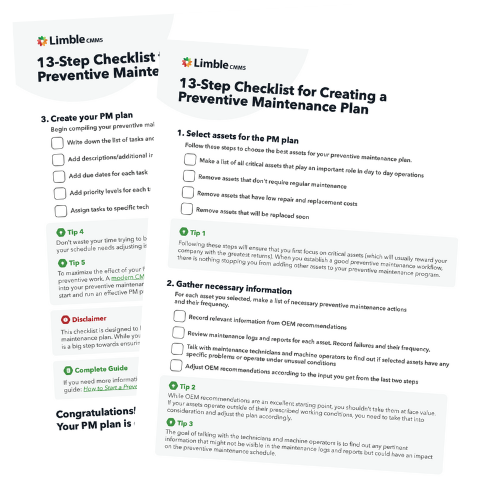
FAQ
How does Limble’s software simplify preventive maintenance?
Limble’s CMMS streamlines preventive maintenance by automating PM scheduling, tracking work orders, providing real-time asset data, and more. Limble’s user-friendly interface, detailed reporting, and customizable Key Performance Indicators (KPIs) make it easy to optimize your PM program for your organization’s needs and goals.
Table of Contents
- Preventive maintenance (PM) involves routine, scheduled maintenance to prevent equipment failure, reduce downtime, and extend asset lifespan.
- What is preventive maintenance (PM)?
- Why is preventive maintenance important?
- Different types of preventive maintenance
- Preventive maintenance programs: getting started
- How does preventive maintenance software benefit organizations?
- Preventive maintenance in action
- The future of preventive maintenance
- More resources for getting started with preventive maintenance
- FAQ
- Related Content
What is the difference between preventive maintenance and predictive maintenance?
While preemptive maintenance and predictive maintenance are both proactive maintenance strategies, they rely on different triggers for task initiation. Whereas preventive maintenance involves regularly scheduled inspections and repairs based on time intervals or usage triggers, predictive maintenance uses real-time data from sensors and advanced analytics to predict when equipment is likely to fail and to intervene accordingly.
Table of Contents
- Preventive maintenance (PM) involves routine, scheduled maintenance to prevent equipment failure, reduce downtime, and extend asset lifespan.
- What is preventive maintenance (PM)?
- Why is preventive maintenance important?
- Different types of preventive maintenance
- Preventive maintenance programs: getting started
- How does preventive maintenance software benefit organizations?
- Preventive maintenance in action
- The future of preventive maintenance
- More resources for getting started with preventive maintenance
- FAQ
- Related Content
How can organizations set up preventive maintenance schedules?
Organizations can set up preventive maintenance schedules by implementing and leveraging CMMS technology. The right CMMS platform should make it easy to automate features like preventive maintenance scheduling, inventory management, work order generation, and more. Organizations hoping to set up effective preventive maintenance schedules should look for CMMS providers who offer easy implementation, dedicated customer support, and integration with existing systems and technology.
Table of Contents
- Preventive maintenance (PM) involves routine, scheduled maintenance to prevent equipment failure, reduce downtime, and extend asset lifespan.
- What is preventive maintenance (PM)?
- Why is preventive maintenance important?
- Different types of preventive maintenance
- Preventive maintenance programs: getting started
- How does preventive maintenance software benefit organizations?
- Preventive maintenance in action
- The future of preventive maintenance
- More resources for getting started with preventive maintenance
- FAQ
- Related Content
Can I connect to other systems?
Limble provides seamless, pre-built CMMS Integrations with the most widely used software systems. That means no help from a developer or your IT team is required. Learn more about our integrations.
Table of Contents
- Preventive maintenance (PM) involves routine, scheduled maintenance to prevent equipment failure, reduce downtime, and extend asset lifespan.
- What is preventive maintenance (PM)?
- Why is preventive maintenance important?
- Different types of preventive maintenance
- Preventive maintenance programs: getting started
- How does preventive maintenance software benefit organizations?
- Preventive maintenance in action
- The future of preventive maintenance
- More resources for getting started with preventive maintenance
- FAQ
- Related Content
How secure is the Limble CMMS platform?
At Limble, our world-class data security practices ensure your account information is safe. We use state-of-the-art technologies and industry best practices to maintain a secure infrastructure, including SOC-II Type II certification, regular penetration testing, and continuous security training for our staff.
Table of Contents
- Preventive maintenance (PM) involves routine, scheduled maintenance to prevent equipment failure, reduce downtime, and extend asset lifespan.
- What is preventive maintenance (PM)?
- Why is preventive maintenance important?
- Different types of preventive maintenance
- Preventive maintenance programs: getting started
- How does preventive maintenance software benefit organizations?
- Preventive maintenance in action
- The future of preventive maintenance
- More resources for getting started with preventive maintenance
- FAQ
- Related Content
